How to Prevent Weeds Taking Over Your Lawn — 8 Tricks Gardening Experts Swear by
Preventative practices and trouble-shooting tips for putting an end to weeds without harming your grass

To maintain a lush lawn in your yard, it's good to know how to kill weeds, but not grass. After all, the indiscriminate use of weedkillers often destroys more than its intended target.
From brown grass to wiping out beneficial bugs and other wildlife, the collateral damage from herbicides is high. So how can we rid our gardens of weeds, without poisoning everything else in sight?
'There is no single, magic answer to make weeds go away safely,' says Tasha Greer, author of Weed-Free Gardening. 'It takes a selection of targeted strategies and regular garden maintenance to stay ahead of potential plant invaders.
'Yet, there are many ways to make weeding easier and more enjoyable, while also improving your soil, growing healthier plants, and enhancing the beauty of your landscape and garden.'
1. Overseed bare patches of grass

Weeds are opportunistic plants that will sprout where they can. This will often be on bare or thinning patches of lawn, where there's no competition from grass or other plant life.
'We often garden in ways that create and exacerbate weed invasions by leaving soil bare or unoccupied or by inviting weeds in with other mistakes,' says Tasha Greer. 'Thankfully, our gardening practices can also be the solution when it comes to managing our weeds organically.'
'Weeds struggle to establish in well-maintained turf,' says Tony O'Neill , founder, Simplify Gardening. 'They thrive in thin bare spots on a lawn because they don't have to compete for resources. Seed thin or bare patches early in the fall each year to thicken the turf. Overseeding will also help to prevent bare patches from appearing on your lawn in the first place.'
The Livingetc newsletters are your inside source for what’s shaping interiors now - and what’s next. Discover trend forecasts, smart style ideas, and curated shopping inspiration that brings design to life. Subscribe today and stay ahead of the curve.
2. Improve your mowing practice

'A thick lawn is your best deterrent for weeds and will be less likely to suffer during dry periods,' says Charlie Nardozzi, author, Month-by-Month Gardening new England. 'Mow lawns to 3 inches tall for the best growth. Mowing high allows the grass to develop a strong root system that results in a lush lawn.'
'Use a mulching mower or traditional mower with a mulching blade,' continues Charlie. 'Mulching blades chop the grass clippings into small pieces so they decompose into the lawn faster. It’s better to leave the clippings than to pick them up because these clippings can add up to one-third of the nitrogen needs of your lawn.
'The exception would be if you allow your lawn to grow too tall due to rainy weather. Ideally, you should never let your lawn grow to more than 4 to 5 inches tall so you won’t take off more than one-third of the total height of grass blade at any one mowing.
'This prevents the grass from getting scalped and not growing strongly. However, if you must mow when it’s high and have piles of dead grass on your lawn, then it’s best to rake and remove the dead grass so it doesn’t smother your lawn.'
Tony O'Neill concurs, 'Maintaining a higher mowing height around three inches can shade out germinating weed seeds, preventing their establishment,' he adds.
3. Dig them up

Elbow grease is often the answer and pulling them up by the roots is a good way to get rid of weeds from a lawn without killing your grass.
'By not pulling weeds as they germinate you're allowing them to seed again,' says Tony O'Neill. 'Pulling them up manually is labor-intensive but effective and worth the effort.'
'Digging up weeds by hand, or with a hori hori knife, is my go-to method for removing them from both the lawn and garden,' says Kat Aul Cervoni, landscape designer and founder of Staghorn NYC and The Cultivation by Kat. 'I find it’s the most effective and least invasive.'
'The hori hori digging knife has a shovel-like shape, pointy digging tip, and a serrated side to use as a cutting tool. It works great for removing shallow taproots with minimal disturbance to the surrounding soil,' says Tasha Greer.
'Find the crown of the plant, move the leaves out of the way, then cut a circle around the root area. Like coring an apple, once you’ve made a complete cut, pull the entire weed out. If it doesn’t come easily, you may have a deeper root.
'If so, use the tip of the knife to cut through the root. Once the shallower part of the plant is out of the way, you should be able to make a deeper cut with your digging knife to finish the job.'
4. Aerate your lawn
Aerating a lawn each year helps the grass access nutrients and water, which makes it healthier. Strong, healthy grass leaves less room for weeds. This is a good preventative measure against weeds, as is fertilizing your lawn. This kind of lawn maintenance is best done around September.
'The key to preventing weed, disease, and insect attacks organically is to have a healthy lawn grass with deep, thick roots,' says Charlie Nardozzi. 'To achieve this, you’ll need to build up the fertility of the soil under your lawn. Aerate existing lawns to provide space for air, water, and fertilizer to reach the roots.
But how to aerate a lawn? 'Rent a core aerator from the local rent-all company or, for small lawns, use an iron fork,' Charlie adds. 'Topdress lawns each fall with a ¼-inch-thick layer of compost raked into the grass. This translates into about 1 yard of compost per 1,000 feet of lawn. The compost will feed the grass roots slowly and provide a good base for the grass to grow thick and lush.
'Overseed lawns with grass seed adapted to your lawn’s growing conditions and fertilize with a granular organic product.'
5. Pour boiling water on weeds
Pouring boiling water on weeds sounds harsh but it can be effective. However, it needs to be done carefully as it can damage surrounding turf. Pour the hot water onto the crown of the plant and around the root zone. Then you can either mow over it or pull it up.
'Boiling water can be a good spot treatment for driveways or walkways, but be cautious as it can harm your grass,' says Tony.
'I recommend boiling water for weeds that you want to avoid touching like poison ivy,' says Kat Aul Cervoni. 'Using a kettle enables you to precisely administer the boiling water directly onto the weed so that surrounding grass, plants (and you) aren’t harmed.'
6. Spray with diluted vinegar
An alternative to boiling water is using high-concentration vinegar to spray or douse weeds with.
'Vinegar should also be applied with precision to avoid damaging surrounding grass or plants and also to avoid burning yourself,' says Kat. 'A concentration of 20% or more is best and should be applied on a warm and sunny day while the plant is photosynthesizing.'
7. Sprinkle corn gluten meal
'Corn gluten meal is an organic pre-emergent herbicide alternative that inhibits weed seed germination,' says Tony O'Neill. 'You can sprinkle it in areas where weeds were growing after pulling them out.'
'Spread corn gluten organic crabgrass killer on your lawn around April when crabgrass seed starts to germinate,' says Charlie Nardozzi. 'This product kills the germinating seeds and is a 10 percent nitrogen fertilizer.
'Don’t spread lawn grass seed in this area for one month, as the corn gluten kills all germinating seeds too.'
8. Allow some "weeds"

Not all weeds were created equal. Many plants that we now call weeds have nutritional and medicinal properties and those such as clover, buttercups and dandelions provide valuable food for pollinators. The exception is invasive species.
'Turf lawns or "green deserts" are ecological wastelands for pollinators, such as butterflies and bees,' says Kim Eierman, author, The Pollinator Victory Garden. 'If you want to support pollinators, determine how much lawn you really need and replace the rest with native flowering plants.
There are now many grass alternatives that people are choosing that are more low maintenance, too. 'For any lawn that you keep, let flowering "weeds" such as clover persist and manage it organically. Synthetic man-made pesticides can be deadly to pollinators. Your family and pets will benefit from this too, not only pollinators.'
'The way we think about weeds today—as garden or agricultural invaders in need of killing—is a recent development that only came about starting in the 1950s when synthetic herbicides made their agricultural debut,' says Tasha Greer.
'Until about seventy years ago many of the plants we call weeds today were valued as free food, medicine, livestock fodder, and kindling, or used in crafts. 'Arguably, this is the pivotal moment when weeds became enemies to be vanquished rather than wild plants to be used, tolerated, or manually controlled.
'It’s okay to pick and choose which weeds you welcome and discourage. The key is not to consider the plants invaders in need of killing, but more like uninvited guests. Some you might be happy to see. Others you’ll be eager to strategically show the door.'
Jacky Parker is a freelance lifestyle journalist and writer, producing a wide range of features for magazines and digital platforms. She has written for Livingetc and its sister titles, Homes & Gardens and Country Homes & Interiors for more than 15 years, both as a freelance contributor and as Acting Digital Editor and Acting Style Content Editor, regularly reporting on the latest interiors, gardens and wellness inspiration, speaking to experts in their respective fields, and discovering the best tips.
Jacky has also written for other publications, including Sunday Times Style, The Telegraph, Architectural Digest, House Beautiful, ELLE Decoration, Red, Grand Designs and more.





